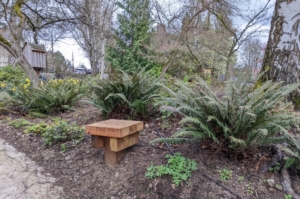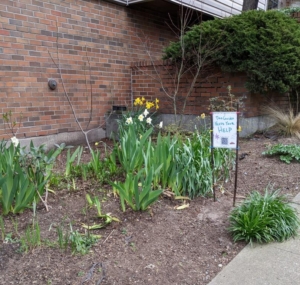Gardening for the Greater Good
Geurrilla gardening is an ancient practice that began centuries ago when property became a commodity, versus a community resource. It is practiced all over the world!
These days, you can ask permission to plant on a site or you can just do it and hope that you or your plants don’t go missing. Below are examples of two people who are making a positive impact on the community, by gardening for the greater good.
FECO has a couple of volunteers who have been gardening in various locations, on the side. Reid has been the most ambitious and his recent handiwork has an interesting twist.
As an avid walker, Reid keeps his eyes attuned to forlorn planting sites. Everyday he walked by an apartment building in Tangletown that had bare soil between the building and the sidewalk. Reid got busy gathering plants that might work well on that west-facing patch. (At FECO, we often have plants to share and sometimes Reid leaves with an arm full.) His site became brighter over time. Now for the watering and maintenance aspect of gardening for the good. Reid stewarded his site but he recently moved and the site in Tangletown lost its caretaker. Reid had an idea. At the site, he pushed a sign in the ground that included a QR code. Here is what the link says:
Hi There!
Thanks so much for your interest in helping us take care of these gardens!
As this document gets into, we’re hoping to find community support around watering, mulching, and weeding the gardens we’ve planted around the Tangletown neighborhood.
This is a labor of love and we need all the help we can get! I no longer live in this neighborhood.
Brilliant. What might come of this? The plants get care, a neighbor or two connect, or someone might duplicate Reid’s effort elsewhere. Community gardening with the community!
for work parties
Sun. April 7, 1-4, Spring Plant Sale
Please email to volunteer
freewayestatescommunityorchard@gmail
My second example involves a giant traffic circle at the intersection of 17th Ave NE and NE Naomi Place (Whitaker Park). SDOT approved a grant application from a neighbor and then proceeded to break up the pavement and add a large mound of soil on top. Markets open! George, a native plant expert, has been adding plants and maintaining the space for years. When he started there was English Ivy, Himalayan blackberry, a couple of English hawthorn and a big weeping birch. Today the space is flush with native plants. (A list of species can be found on the Washington Native Plant Society’s (WNPS) website. )
George acknowledges that government jurisdictions vary in their approach to citizen involvement in public spaces. The emphasis of each jurisdiction tends to fall into one of three buckets: 1) offer relevant support, 2) simply record volunteer hours or, 3) they ask that you do it on Sunday.
George is actually the go-to person around town for design and plant choices for gorilla gardening sites. When he walks about it’s as if he has a paper route, delivering care and attention to several little gardens.
I asked him what his best tip would be for the new Geurrilla gardener. I thought he might respond with, ‘get the neighbors on board’ or, ‘check in with the Green Seattle Partnership’. His response? “Penstemon.”
Ruth
reference – Tracey, David, Guerrilla Gardening: A Manualfesto, 2007


Leave a Reply
Want to join the discussion?Feel free to contribute!